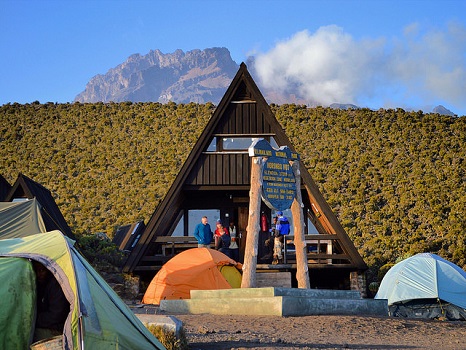What i wish i knew before climbing Kilimanjaro
What i wish i knew before climbing Kilimanjaro? Climbing Kilimanjaro is an adventure that tests physical challenges, offering a journey of self-discovery and awe-inspiring landscapes. The highest peak in Africa, Mount Kilimanjaro stands as a majestic sentinel, attracting more climbers to its snow-capped summit. Climbing Kilimanjaro is a symphony of ecosystems, from lush rainforests teeming with diverse flora and fauna to alpine deserts and glacial expanses at higher elevations. On climbing Kilimanjaro, its slopes demands not only physical stamina but also mental resilience, as climbers navigate through ever-changing weather conditions and acclimate to the decreasing oxygen levels. The friendship and connection among fellow climbers, the guidance of experienced guides, and the beauty of the mountain create an unforgettable tapestry of moments. Reaching the Kilimanjaro summit, Uhuru Peak, at sunrise is a profound culmination, as the vastness of the African continent unfolds below, symbolizing not just a conquered peak but a personal achievement and a connection to the indomitable spirit of nature.
What i wish i knew before climbing Kilimanjaro : Overview
What i wish i knew before climbing Kilimanjaro, The journey of climbing Kilimanjaro is an expedition that promises unforgettable experiences and profound challenges. For many adventurers, the feeling of scaling Africa's highest peak ignites a sense of excitement and anticipation, accompanied by visions of breathtaking vistas and triumphant summits. But beneath the surface of this epic expedition lies different insights and preparations that, if known beforehand, could significantly enhance the journey. From physical conditioning to mental preparations, from understanding altitude sickness to respecting the environment, there exists a wealth of knowledge that climbers often wish they possessed before setting foot on Kilimanjaro's rough terrain.
The ascent of Kilimanjaro stands as an emblem of both personal achievement and natural wonder, attracting climbers to its lofty heights with the promise of adventure and self-discovery. Yet, among the beauty of summiting Africa's highest peak lies a landscape full with challenges and uncertainties that test the resolve and resilience of even the most seasoned mountaineers. As aspirants prepare to go on this extraordinary journey, they are confronted with the realization that there are different aspects of the journey they wish they had known beforehand. From the intricacies of altitude acclimatization to the nuances of route selection, each revelation serves as a beacon of insight, illuminating the path towards a more informed and empowered ascent of Kilimanjaro's majestic slopes. Kindly Book with us for the best kilimanjaro climbing packages on all routes through our email : redetours2005@gmail.com Or send your enquiry here.
What i wish i knew before climbing Kilimanjaro : Key guides
Training and Preparation
Adequate physical training and preparation are vital prerequisites before go on a climb up Kilimanjaro. Engage in a structured training regimen that includes cardiovascular exercises, strength training, and hiking to build the necessary stamina and endurance for the challenging ascent. Incorporate long hikes with elevation gain to simulate the conditions of the climb and familiarize yourself with carrying a backpack over extended periods. Consistent training not only enhances physical fitness but also boosts confidence and mental resilience, enabling climbers to tackle the demanding terrain with greater ease and determination.
Slow and Steady Pace (Pole pole)
Adopting a slow and steady pace is a fundamental strategy for a successful ascent of Kilimanjaro. The altitude and rugged terrain necessitate a deliberate approach to conserve energy and facilitate acclimatization, that is why most guide came up with the slogan "Pole pole Hakuna Matata!!" to help climbers go slow and ensure high summit success. Climbers should adhere to a sustainable pace that allows for gradual progress while minimizing the risk of exhaustion and altitude-related ailments. Taking regular breaks to rest, hydrate, and refuel enables the body to adjust to the decreasing oxygen levels and alleviate symptoms of altitude sickness. By embracing a patient and methodical pace, climbers can optimize their chances of reaching the summit safely and enjoyably.
Pack Light, Pack Right
Selecting and packing the appropriate gear is important for a successful Kilimanjaro ascent, emphasizing the principles of minimalism, functionality, and efficiency. Prioritize lightweight, durable equipment and clothing that strike a balance between essential functionality and space-saving design. Streamline your packing list by focusing on multi-purpose items and eliminating non-essential luxuries to minimize the weight of your backpack and optimize mobility on the trail. Invest in high-quality, weather-resistant gear tailored to the specific demands of the Kilimanjaro climate and terrain, including sturdy hiking boots, insulated layers, a reliable sleeping bag, and a durable backpack. By adhering to a minimalist packing philosophy and prioritizing functionality over excess, climbers can enhance their agility, comfort, and overall enjoyment of the ascent.
Hydration and Nutrition
Maintaining optimal hydration and nutrition levels is paramount throughout the duration of the Kilimanjaro climb. Adequate hydration helps regulate body temperature, prevent dehydration, and support vital bodily functions, particularly at high altitudes where fluid loss is accelerated. It is imperative to consume water consistently throughout the day, even when not feeling thirsty, to counteract the effects of altitude and exertion. Likewise, prioritizing nutrient-dense meals and snacks rich in carbohydrates, proteins, and healthy fats provides sustained energy and replenishes depleted stores during strenuous activity. Proper hydration and nutrition form the cornerstone of physical well-being and performance, enabling climbers to endure the rigors of the climb and optimize their overall experience on Kilimanjaro.
Altitude Sickness Awareness
Acquiring a comprehensive understanding of altitude sickness and its potential ramifications is essential for climbers ascending Kilimanjaro. Altitude sickness, characterized by symptoms such as headache, nausea, dizziness, and fatigue, can manifest as climbers ascend to higher elevations due to reduced oxygen levels in the atmosphere. Familiarizing oneself with the early warning signs and symptoms allows for prompt recognition and intervention to prevent escalation and ensure the safety of all participants. Climbers are encouraged to communicate openly with their guides and fellow team members regarding any discomfort or distress experienced, facilitating timely assistance and appropriate action to mitigate the effects of altitude sickness. Vigilance, awareness, and proactive management are paramount in safeguarding the well-being and success of climbers tackling the formidable heights of Kilimanjaro.
Weather Conditions
Kilimanjaro's unpredictable and varied weather conditions pose a significant challenge for climbers, necessitating meticulous preparation and adaptation. The mountain's diverse microclimates encompass scorching heat, biting cold, torrential rain, and fierce winds, often within the span of a single day. Climbers must equip themselves with a versatile array of clothing and gear to contend with the ever-changing elements and maintain comfort and safety throughout the journey. Layering lightweight, moisture-wicking fabrics facilitates temperature regulation and moisture management, while waterproof outerwear provides protection against precipitation and wind chill. By remaining attuned to weather forecasts and heeding the advice of experienced guides, climbers can optimize their gear selection and strategic planning to mitigate the impact of adverse weather conditions and enhance their resilience in the face of nature's unpredictability.
Mental Resilience
Cultivating mental resilience and fortitude is indispensable for navigating the myriad challenges and uncertainties inherent in the Kilimanjaro climb. Embrace a positive mindset characterized by adaptability, perseverance, and a solution-oriented approach to adversity, empowering you to overcome obstacles and setbacks with grace and determination. Practice mindfulness techniques, visualization exercises, and positive self-talk to bolster mental clarity, focus, and emotional equilibrium throughout the ascent. Draw strength and inspiration from the awe-inspiring beauty of Kilimanjaro's natural landscape, harnessing its transformative power to fuel your resolve and sustain your motivation during moments of fatigue or doubt. By embracing the journey as a profound test of character and personal growth, climbers can forge indelible memories and emerge from the experience with newfound resilience, insight, and self-discovery.
Mental Preparation
Demonstrating reverence for the pristine natural environment and rich cultural heritage of Kilimanjaro is integral to fostering sustainable tourism practices and fostering mutual respect and understanding among climbers and local communities. Adhere to Leave No Trace principles by minimizing environmental impact, disposing of waste responsibly, and preserving the integrity of fragile ecosystems and wildlife habitats. Embrace opportunities for cultural exchange and engagement with indigenous communities, demonstrating sensitivity to local customs, traditions, and protocols while fostering meaningful connections and mutual appreciation across cultural divides. By cultivating a spirit of stewardship and cultural humility, climbers can contribute positively to the preservation of Kilimanjaro's natural and cultural heritage, leaving behind a legacy of respect, reciprocity, and harmony for future generations to cherish and uphold.
Safety First
Prioritizing safety and risk management is paramount throughout every stage of the Kilimanjaro climb, underscoring the importance of vigilant preparation, clear communication, and collaborative decision-making among climbers and guides. Familiarize yourself with emergency protocols, evacuation procedures, and safety guidelines established by reputable tour operators and regulatory authorities to mitigate potential hazards and respond effectively to unforeseen contingencies. Maintain open lines of communication with your expedition team, articulating any concerns or discomforts promptly and transparently to facilitate timely intervention and support. Adhere to established safety protocols, heed the guidance of experienced guides, and exercise prudent judgment in assessing environmental conditions and personal limitations. By embracing a culture of safety consciousness and mutual accountability, climbers can minimize risks, enhance preparedness, and cultivate a shared commitment to ensuring the well-being and welfare of all participants throughout the Kilimanjaro expedition.Kindly Book with us for the best kilimanjaro climbing packages on all routes through our email : redetours2005@gmail.com Or send your enquiry here.
What i wish i knew before climbing Kilimanjaro : What to pack
Quality Hiking Boots
One of the most crucial items to carry on a Kilimanjaro climb is a pair of high-quality hiking boots. These boots should be comfortable, sturdy, and well broken-in to prevent blisters and provide adequate support on the rugged terrain. Opt for waterproof and breathable boots with excellent traction to navigate through various landscapes, including rocky trails, muddy paths, and snow-covered slopes. Investing in reliable hiking boots ensures stability, protection, and comfort throughout the ascent, enhancing your overall hiking experience and reducing the risk of foot-related injuries or discomfort.
Insulated Clothing Layers
Kilimanjaro's climate can vary dramatically, from scorching heat at lower elevations to freezing temperatures at higher altitudes. Carrying insulated clothing layers is essential to stay warm and comfortable throughout the climb. Pack thermal base layers, fleece jackets, insulated pants, and a windproof, waterproof outer shell to layer according to changing weather conditions. Opt for lightweight, moisture-wicking fabrics that offer warmth without bulk, facilitating easy movement and temperature regulation during strenuous activity. Properly layering your clothing ensures versatility, adaptability, and protection against the elements, allowing you to maintain comfort and performance in diverse environments.
Hydration bladder or Water bottle
Staying hydrated is paramount for maintaining energy levels, preventing altitude sickness, and optimizing performance during the Kilimanjaro climb. Carrying a reliable hydration system, such as a hydration bladder or water bottles, ensures easy access to clean drinking water throughout the ascent. Choose a hydration system with a sufficient capacity to meet your fluid intake needs and consider insulated options to prevent water from freezing at higher elevations. Prioritize regular hydration breaks and consume water consistently, even when not feeling thirsty, to counteract the effects of altitude and physical exertion. Proper hydration supports overall well-being, enhances acclimatization, and reduces the risk of dehydration-related complications, contributing to a safe and enjoyable climbing experience.
High-Altitude Sleeping Bag
A high-altitude sleeping bag is an essential item for overnight stays at Kilimanjaro's campsites, where temperatures can plummet to sub-zero levels, especially at higher elevations. Choose a sleeping bag specifically designed for cold weather conditions, with a temperature rating that accommodates freezing temperatures. Look for lightweight, compressible options with high-quality insulation to maximize warmth and minimize bulk during transport. Additionally, consider using a sleeping bag liner or insulated sleeping pad for extra insulation and comfort on rocky or uneven surfaces. Investing in a high-altitude sleeping bag ensures restful sleep, thermal regulation, and essential protection against the cold, facilitating recovery and rejuvenation for the challenges ahead.
Any Medications prescribed by the doctor
Carrying essential medications is paramount for addressing common ailments and mitigating health risks during the Kilimanjaro climb. Pack a personalized first aid kit containing over-the-counter medications for pain relief, anti-inflammatory drugs, antihistamines, and remedies for gastrointestinal discomfort. Additionally, include prescription medications for specific health conditions, such as altitude sickness prevention medications or treatments for respiratory infections. Consult with a healthcare professional to determine the appropriate medications based on your medical history, altitude tolerance, and individual health needs. Having access to essential medications ensures prompt treatment of minor injuries, illnesses, or altitude-related symptoms, enhancing safety, comfort, and peace of mind throughout the climbing expedition.
Necessary Documents
Carrying necessary documents is crucial for a smooth and organized Kilimanjaro climbing expedition. Ensure you have your passport, visa (if required), and any permits or park fees required for the climb. Keep these documents in a waterproof and secure pouch to protect them from moisture and damage during the journey. Additionally, carry copies of important documents, such as travel insurance details, emergency contact information, and medical records, in case of unforeseen circumstances or emergencies. Having the necessary documents readily accessible facilitates entry into the country, compliance with regulations, and efficient coordination with local authorities and tour operators throughout the Kilimanjaro expedition.
What i wish i knew before climbing Kilimanjaro : popular Routes
5 Days Marangu Route Kilimanjaro Climbing
The 5-day Marangu Route offers climbers a relatively shorter and less strenuous option to summit Kilimanjaro, making it popular among trekkers seeking a quicker ascent. Known as the "Coca-Cola" route due to its amenities like hut accommodations, the Marangu Route provides a comfortable trekking experience. Over the course of five days, climbers traverse through diverse landscapes, including lush rainforests, moorlands, and alpine deserts, before reaching the iconic summit of Uhuru Peak. While the Marangu Route is the only path with hut accommodations, its shorter duration and higher traffic can pose challenges for acclimatization, requiring climbers to be mindful of altitude sickness symptoms and take necessary precautions for a successful summit bid.
6 Days Machame Route Kilimanjaro Climbing
The 6-day Machame Route, often dubbed the "Whiskey" route, is renowned for its scenic beauty, diverse terrain, and excellent acclimatization profile. As one of the most popular routes on Kilimanjaro, the Machame Route offers a more gradual ascent, allowing climbers ample time to adjust to the altitude and increase their chances of reaching the summit successfully. Over six days, trekkers traverse through dense rainforests, moorlands, and alpine deserts, passing stunning landscapes like the Shira Plateau and Barranco Wall. The Machame Route's longer duration and challenging terrain make it suitable for adventurers seeking a more immersive and rewarding climbing experience, with opportunities to marvel at Kilimanjaro's breathtaking scenery and forge lasting memories along the way.
7 Days Lemosho Route Kilimanjaro Climbing
The 7-day Lemosho Route is revered for its unparalleled scenic beauty, low crowds, and excellent acclimatization profile, making it one of the most sought-after routes for climbing Kilimanjaro. Known as the "Northern Circuit," the Lemosho Route offers trekkers a gradual and less congested ascent, allowing ample time for acclimatization and maximizing the chances of reaching the summit of Uhuru Peak successfully. Over the course of seven days, climbers traverse diverse landscapes, from lush rainforests teeming with wildlife to high-altitude alpine deserts, soaking in panoramic vistas of the surrounding savannah and distant peaks. The Lemosho Route's longer duration and remote wilderness experience make it ideal for adventurers seeking a comprehensive and immersive Kilimanjaro climbing expedition, characterized by camaraderie, discovery, and the triumph of summiting Africa's highest peak.
How to book for Kilimanjaro climbing tours on all routes
Book for Kilimanjaro climbing tours on all routes by sending us the email via redetours2005@gmail.com Or Use the Booking form below.
Our Best Tanzania Safari Tours For 2023 & 2024






